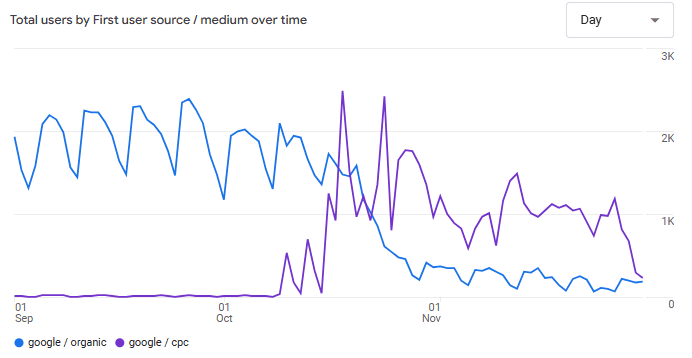SEO and Paid Search: Combining Strategies for Maximum Search Visibility
Search Engine Optimization (SEO) and paid search are tactics cut from the same cloth, both aiming to capture traffic in search engine results pages (SERPs) through keyword targeting. While they share this common goal, their approaches differ significantly.
SEO is a long-term strategy focused on organic growth through content creation, technical optimization, and building site authority. Besides potential content creation costs, it’s essentially free – but requires patience and consistent effort.
Paid search, or pay-per-click (PPC) advertising, offers immediate visibility but at a cost per click. Platforms like Google Ads and Bing Ads make it easy to start driving traffic quickly, provided you have the budget.
Understanding when and how to use each channel is crucial for an effective search marketing strategy. Let’s explore their unique functions and how they work together.
Use Cases for SEO and Paid Search
In SEM strategy, both SEO and paid search must play complementary roles. That means while they can target the same keywords, they have unique goals.
Search Engine Optimization
According to Moz, 80% of keyword intent in search engines is informational. Users often only search for the answer to a question with no particular intent to purchase something.
SEO content uses this intent to educate users on a particular topic. While this doesn’t provide any monetary value, it does start to build awareness for a brand.
This brand awareness is incredibly important in driving downstream purchase intent. Think of SEO as a discovery channel, filling the top of the funnel with potential customers.
Paid Search Advertising
Paid search ads are more uniquely focused on commercial and transactional intent – keywords are aimed at driving a sale.
This is why most savvy search advertisers know that keywords with identifiers like ‘best’, ‘top’, or ‘price’, often mean the searcher is closer to making a purchase.
Where SEO aims to build awareness and demand for a product, paid search aims to capture it by engaging users closer to point of sale.
Best Use Cases for SEO
Organic search offers a chance to build an audience purely from content. While it takes more time, this proves advantageous in certain scenarios.
New Businesses
The days of cheap PPC advertising are over. With paid search requiring significant budgets and no guarantee of profitability, SEO offers a cost-effective alternative. Content allows you to test messaging without paying for each click, while building long-term audience value.
Take Hubspot – their strategic focus on SEO content targeting marketing professionals enabled rapid growth without heavy reliance on paid ads.
New Product Categories
Products without established search volume face challenges with paid advertising. Consider Athletic Greens (now AG1) – rather than solely targeting direct product searches, they create content about gut health, probiotics, and nutrition. This approach builds awareness by educating potential customers about problems their product solves, rather than pushing immediate sales.
Important Note: Social media can also help generate demand, organically or through a channel like Facebook ads.
Highly Competitive Markets
In markets with competitive keywords, SEO provides vital reach without breaking the bank. Take enterprise software – companies like Segment face keywords costing $100+ per click. While potential revenue from a CDP sale could justify these costs, organic content helps mitigate risk while nurturing prospects through educational content.
All three examples show cases where building awareness in a crowded market is imperative, and SEO is a cost-effective way to do so.
Best Use Cases for Paid Search
Paid search marketing has long been considered the gold standard in digital marketing due its commercial and transactional intent. Put simply, a paid search result is perfect for selling a product or service.
Search ads have the unique advantage of placement above organic search results, meaning they are effective at driving results fast. This contributes to some key functions.
Message Testing
Paid search ads offer an excellent testing ground due to their ability to drive traffic quickly. Ad copy can test things like hooks, benefits, and unique selling propositions (USPs) – vital parts of a content marketing strategy.
Winning variants can be incorporated broadly into a marketing strategy across organic search as well as the website and social media.
There are also cases where paid search isn’t just about testing but rather maintaining visibility. This is particularly true for…
Overlapping Brands
Brands with the same or similar brand name to another company may find it better to run paid search ads to avoid confusion when they’re not listed at the top of page.
This is also a common way to avoid conquesting (competitors bidding on your brand name) – see Branded Search Campaigns: When to Invest and When to Skip for more on when to run this type of campaign.
While brand overlap is a viable scenario to run paid search, it’s equally important with product overlap.
E-Commerce
Product listings for shoppable items like clothes, electronics, or supplements face intense competition in search results. With shopping ads and product cards often appearing above organic listings, visibility can be severely limited without paid advertising.
Search ads or product listing ads (PLAs) solve this challenge by ensuring visibility above the fold through product feeds. This ad placement is crucial – ads in the first position typically drive up to 2x more clicks than those in second or third place, making top-of-page visibility essential for capturing sales.
So, how can a paid search campaign and seo campaign work together? Let’s break down where they overlap.
How SEO and Paid Search Work Together
A cohesive SEO and PPC marketing strategy drives results. Aligning these strategies requires careful planning at each step of the process.
As mentioned earlier, SEO content acts as an educational resource while paid search ads are aimed at driving a sale. This means keywords need to be unique, but aligned.
Keyword Research
Keyword research involves the choosing of particular target keywords or key phrases to show content or ads. Start with a tool like Google Keyword Planner to find keywords that are being searched for.
SEO Keyword Research
When choosing keywords for SEO content, three key factors matter:
- Competition: How many other sites are targeting this keyword?
- Monthly search volume: Are enough people searching for this term?
- Content relevance: Can you create valuable content around this topic?
Long-tailed keywords – longer phrases that combine several keywords – often work best when starting out. They let you create hyper-specific content for less competitive topics, finding that sweet spot between search volume and ranking potential.
Paid Search Keyword Research
Paid search targets keywords through exact match or related match (phrase and broad). The considerations are similar but with a crucial difference:
- Competition
- Monthly search volume
- Keyword intent
The focus on intent is what sets paid search apart. Keywords with qualifiers like ‘best running shoes’ or ‘top CDP’ signal commercial intent, making them more valuable for paid campaigns. However, with modern conversion-based bid models, user behavior now matters more than specific terms. See Google’s Ad Auction: Why Target CPA Creates a Premium Bidding Problem for more on how bid models work.
A strong SEO strategy that builds awareness of a brand is crucial, but so is minimizing overlap between organic and paid keywords. Left unchecked, paid search will often capture clicks that could have been earned through organic rankings.
Preventing Paid and Organic Search Conflicts
Paid search will capture a click most of the time even if a brand’s organic search result is in the top position on page. We saw this firsthand with a recent client – after launching their paid search campaign, organic traffic dropped by 75% despite maintaining top organic rankings. This meant we were wasting ad spend paying for clicks that we previously captured for free through SEO.

This cannibalization of organic traffic by paid search is a common challenge. While removing all overlap between organic and paid keywords isn’t feasible (or even desirable in some cases), managing this overlap strategically is crucial for both channels’ success.
Managing Bids Based on Organic Performance
When integrating SEO and paid search efforts, bid management becomes a critical consideration. While some keyword overlap between channels is unavoidable, strategically managing this relationship can significantly improve your overall marketing efficiency. Consider this two-step approach:
Assess Organic Visibility Tiers
Begin by categorizing your keywords based on their current organic rankings. This creates a foundation for making strategic bidding decisions:
- Top performers: Keywords with excellent organic visibility (typically positions 1-3)
- Mid-range performers: Keywords with moderate organic visibility (typically positions 4-10)
- Opportunity keywords: Keywords with limited organic visibility (beyond position 10)
Implement Tiered Bidding Adjustments
With this categorization in place, adjust your paid search approach accordingly:
- For top organic performers: Consider modest bid reductions to prevent unnecessary ad spend while maintaining some paid presence
- For mid-range performers: Apply minimal bid adjustments while monitoring overall visibility
- For opportunity keywords: Consider more aggressive bidding to compensate for limited organic visibility
This approach requires:
- A flexible bid management system (manual CPC or maximize clicks typically work best)
- Regular monitoring of organic position changes
- Performance analysis of combined (paid + organic) visibility metrics
For more on how to execute this approach, see keyword bid management automation.
How to Measure SEO and Paid Search Success
A cohesive strategy aims to capture maximum traffic through organic search, ultimately saving budget for other acquisition channels. The success of this approach can be measured through three key metrics:
- Increased Total Search Traffic
- Track the overall growth in search visitors, combining both paid and organic channels. This shows whether your strategy is expanding total reach.
- Increased Non-Branded Organic Search
- Monitor growth in organic traffic from non-branded terms. This indicates your SEO content is successfully reaching new audiences.
- Lower Cost Per New Customer
- Watch for declining acquisition costs over time. As organic traffic grows, you should see better overall marketing efficiency.
Monitor these metrics through Google Search Console to gain deep insights into your organic search performance. Keep in mind that SEO results aren’t immediate – analyze trends quarterly rather than monthly to better understand the long-term impact on marketing efficiency.
Building A Cohesive Search Engine Marketing Strategy
A successful search marketing strategy isn’t about choosing between SEO and paid search – it’s about leveraging each channel’s strengths. SEO builds a foundation through informational content and brand awareness, while paid search captures high-intent traffic and drives immediate results.
The key is managing how these channels work together. Through careful keyword planning, strategic bid adjustments based on organic rankings, and consistent performance monitoring, you can maximize visibility in search results while avoiding costly overlap. Whether you’re a new business focusing on SEO to build awareness, or an established brand using paid search to maintain visibility in competitive markets, success comes from treating these channels as complementary rather than competitive.
Measure success through increased organic traffic, growing non-branded search presence, and improved customer acquisition costs. Remember that while paid search delivers quick wins, the long-term value of a strong SEO strategy makes the combination of both channels more powerful than either one alone.
